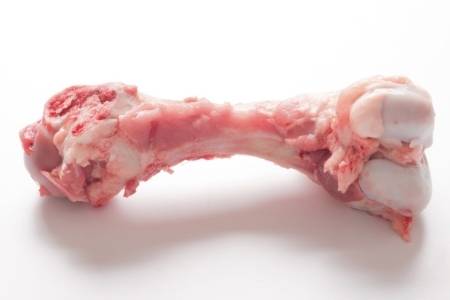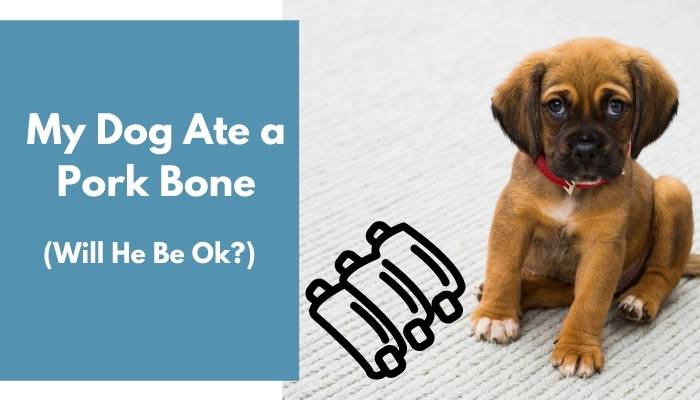One of the things we know about dogs is that they do well with bones. In fact, many kinds of dog treat even have that bone shape. Still, as much as we are familiar with the scene, you may feel surprised at how it can be a risk. So, you may ask:
My dog ate a pork bone, will he be OK? Dogs may like pork bones, it doesn’t mean it’s safe. Pork bones are thick that it can even be hard even for dogs. It can also splinter, and the sharp edges can damage your pet’s internal organs. Thus, if your dog ate a pork bone, check for symptoms and take it to the vet if it shows any signs.
Dogs won’t do well with bones unlike what we believe. If you feed such to your dog, you put it at risk of many complications. If left unchecked, it can even put your pet’s life in danger.
In this article, we’ll tackle everything you need to know about pork bones, and it’s effects on dogs. This way, you can be confident your pet remains safe from incidents related to this matter.
Without further ado, let’s get into it!
Contents
- 1 Can dogs eat pork bones?
- 2 Can a dog digest a pork bone?
- 3 How long does it take a dog to digest a pork bone?
- 4 Can pork bone kill a dog?
- 5 What should I do if my dog ate a pork bone?
- 6 Symptoms that your dog ate a pork bone
- 7 My dog ate a pork chop bone – what to do?
- 8 Dog ate pork femur bone – what to do?
- 9 Dog ate pork shoulder bone – what to do?
- 10 My dog ate pork bones and is pooping blood – what to do?
- 11 My dog ate a pork bone and has diarrhea – what to do?
- 12 Summary
- 13 Resources
Can dogs eat pork bones?
Dogs can eat pork bones, but it entails many risks. Thus, feeding pork bones should be at your own discretion.
As I said earlier, bones are brittle when cooked, and they can splinter when chewed. Such splinters can form sharp edges that can cause many complications.
Now, if you feed raw pork bones, it may not be as brittle. However, it may contain bacteria that can cause diseases to your pet if eaten.
For this reason, it would be best not to give bones of any kind to dogs.
You May Also Read – My dog ate AirPod: what should I do now?
Can a dog digest a pork bone?
Dogs can take on many kinds of food and it’s all thanks to their digestive system. However, a pork bone may cause an issue for dogs to digest.
Due to its large size, a pork bone may only pass through the stomach without digesting it. Thus, it may also pass through the intestines. The problem with this bone would be its edges once it splinters.
The thing about pork bones is that it’s quite large and thick for dogs to digest. Moreover, pork bones, either raw or cooked, can splinter and crack with every chew of dogs.
While they may bite and chew the bone, its sharp edges can cause injury to your pet’s throat. It can also cause choking, intestinal blockages, and damage to the esophagus or intestines.
How long does it take a dog to digest a pork bone?
Among all mammals, dogs have the smallest digestive system. Thus, it only takes about 8 hours to finish the whole process. Of course, it would still vary depending on the dog’s size and breed.
If your pet ate a pork bone, it likely wouldn’t take that long for it to pass through. However, it’s not likely that it will get digested either.
Of course, dogs can digest some bones. However, it’s not something unique for dogs. The thing is that other animals can also do so. Among these are bears, hyenas, vultures, tortoises, and even rabbits.
In fact, we can also digest bones if we want. The only thing is that a pork bone is large enough for dogs to digest. Thus, it can be quite difficult for them to do so.
Can pork bone kill a dog?
A pork bone can kill a dog if the boned choked or caused an intestinal blockage upon eating. All kinds of incidents related to eating bones are dangerous for dogs.
Thus, if left unchecked or untreated, it can take the life of your pet. For instance, choking can lead to your pet’s death if you don’t attend to it as soon as possible.
Intestinal blockages need an operation or other complicated treatment to get solved.
Still, circumstances would vary from time to time, and it has a lot of factors to consider.
For instance, not all bones are equal. Some bones are more comfortable to chew, while others aren’t. Some bones tend to crumble, while others crack and produce sharp edges.
If your dog ate bird bones, it would be thin, full of air sacs, and therefore easy to break. However, pork bones coming from pigs or even bones from cows are massive.
In general, these are the following factors that can determine the seriousness of your pet’s incident.
- The size of the bone
- The type of bone
- The size and health of your dog
- The condition of your dog’s teeth
- Your dog’s relative tendency to chew her food
If your dog’s symptoms are severe, it would be best to take it to the vet as soon as possible.

What should I do if my dog ate a pork bone?
As I said, a pork bone is large enough to pose many risks for your pet. Thus, if your pet ate one, you may need to make some immediate response.
You can use the following response if you see your dog ate a pork bone:
Check for signs that your dog ate a bone.
Observe the area for bone fragments, scattered food, and other signs. Do this, especially if you’re unsure of the kind of bone your dog ate.
It will also help determine how large the bone is and how many pieces your dog ate.
Look into your dog’s throat.
Examine your dog’s mouth and throat and check if the bone is stuck on the throat.
It will also help you determine if you can remove the bone or need assistance.
Touch your dog’s stomach to check for pain.
Touch your pet’s stomach and look for reactions indicating pain. A light press would be enough to do so. If your pet cringes or acts in pain, then you’ll need to take it to the vet.
Check your pet’s reaction.
Is your pet whining or howling? If so, it can be a sign that there’s an intestinal blockage.
Take it to the vet.
Take your pet to the vet as soon as you determine how serious it is.
A severe injury from pork bones needs the help of an expert. Thus, it would be best to take your pet to the vet’s clinic as soon as possible.
If left unchecked, it can result in your pet’s life is at risk. The condition may also worsen if you don’t attend to it immediately.
You May Also Read – My dog ate a rib bone, will he be OK?
Symptoms that your dog ate a pork bone
If your dog ate a pork bone, chances are it will show severe symptoms if the bone started causing a problem.
Thus, you may want to observe your dog for these symptoms, as it will help you determine how serious the situation is.
Body Language
Some dogs will show body language to indicate they are in pain or suffering from the bones.
- Whining
- Shaking
- Weakness
- Raspy panting
Other Signs
Other signs are symptoms that your pet has difficulty due to the pork bone.
- Vomiting or retching
- Bloody stool,
- Diarrhea
- Other digestion issues
- Stomach pain
- Not eating
- Restlessness
- Drooling
My dog ate a pork chop bone – what to do?
The thing about pork chop bone is it’s a bit smaller than the bones found in other parts.
Due to a small size, large-sized dogs can easily chew it up and break it. It won’t likely cause a blockage on your dog. However, the splinters can still damage your pet’s esophagus and intestines.
For this reason, take a good look and observe your pet for signs of complications. Among these would be a bloody stool.
This problem comes from the bleeding of organs due to the sharp edges of the bone.
It may be alright for many dogs. However, if your pet shows some complications, it would be best to contact a vet.
Dog ate pork femur bone – what to do?
Pork femur bones are the typical bones we see in many cartoons and even pictures of dogs. Since it’s a big one, breaking it would be difficult.
Moreover, due to its large size, dogs would find it amusing to chew for a long time.
As long as your pet only chews the femur bone, you have nothing to worry about with its safety.
However, if your dog swallowed it (which isn’t likely), it can cause a blockage. Therefore, it will need immediate attention and treatment.
Dog ate pork shoulder bone – what to do?
Pork shoulder bone can be small depending on the cut. However, it remains quite thick for dogs to break and consume.
In general, bones do not digest in the gut. Instead, it simply passes through the gut and will eventually come out.
If the pork shoulder bone has no sharp edges and gets swallowed whole, it may simply pass without issues.
However, it can still cause a blockage. Thus, your pet would need immediate attention once it starts showing complications.
My dog ate pork bones and is pooping blood – what to do?
A bloody stool is one of the symptoms of an intestinal blockage and damage due to the sharp edges of pork bones.
If such a thing happened, it means your pet is having problems with the pork bones. Thus, you need to respond immediately to aid your pet.
A bloody stool may not appear until a few days after. If your pet seems fine despite the bloody stool, you may want to give your pet a bland diet.
You can try offering plain boiled white rice and skinless boiled chicken breast. It’s almost the same as treating your pet from diarrhea.
If there’s much blood, it means there’s active bleeding in the gastrointestinal tract. Such a complication requires immediate attention, so contact your vet right away.
What should you do if your dog ate a bird or earbuds? Check it out!
My dog ate a pork bone and has diarrhea – what to do?
If your dog suffers from diarrhea after eating a pork bone, you’ll need to continuously check on it.
One of the things you need to observe is its stool to see if there’s any blood or bone in it.
If your pet shows signs of recovery after a day or two, then there’s nothing to worry about with it.
However, if it includes vomiting, painful belly, lack of appetite, fever, or lethargy, then consult a vet for immediate attention.
You can also try to feed your dog with rice (but not brown one).
Summary
While we think bones and dogs suit each other, it’s not entirely true. Although our dogs can chew bones with their strong jaws, their throats and intestines may suffer.
Some pork bones may be big enough to cause a blockage. Other pork bones may be small, but sharp enough to cause bleeding. Thus, whatever the kind of pork bone, it won’t do any good for dogs.
All kinds of bones have risks involved with our dogs. Thus, it would be best to avoid such incidents by refraining from giving your dog bones.
It will save you the worries and the risks of feeding pork bones to your dog.
Resources
Image credits – Canva



